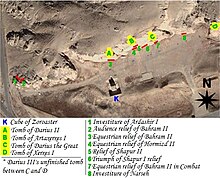
Back نقش رستم Arabic Nəqşi-Rüstəm Azerbaijani Накш-е Ростам Bulgarian নাকশে রোস্তম Bengali/Bangla Naqsh-e Rostam Catalan Naqsh-e Rostam CEB Nakš-e Rustam Czech Naqsch-e Rostam German Nakŝ-e Rustam Esperanto Naqsh-e Rostam Spanish
 | |
 | |
| Location | Marvdasht, Fars province |
|---|---|
| Region | Iran |
| Coordinates | 29°59′20″N 52°52′29″E / 29.98889°N 52.87472°E |
| Type | Necropolis |
| History | |
| Periods | Achaemenian, Sassanian |
| Cultures | Persian |
| Management | Cultural Heritage, Handicrafts and Tourism Organization of Iran |
| Architecture | |
| Architectural styles | Persian |
Naqsh-e Rostam (lit. 'mural of Rostam'; Persian: نقش رستم, Persian: [ˌnæɣʃeɾosˈtæm]) is an ancient archeological site and necropolis located about 13 km northwest of Persepolis, in Fars province, Iran. A collection of ancient Iranian rock reliefs are cut into the face of the mountain and the mountain contains the final resting place of four Achaemenid kings, notably king Darius the Great and his son, Xerxes. This site is of great significance to the history of Iran and to Iranians, as it contains various archeological sites carved into the rock wall through time for more than a millennium from the Elamites and Achaemenids to Sassanians. It lies a few hundred meters from Naqsh-e Rajab, with a further four Sassanid rock reliefs, three celebrating kings and one a high priest.
Naqsh-e Rostam is the necropolis of the Achaemenid dynasty (c. 550–330 BC), with four large tombs cut high into the cliff face. These have mainly architectural decoration, but the facades include large panels over the doorways, each very similar in content, with figures of the king being invested by a god, above a zone with rows of smaller figures bearing tribute, with soldiers and officials. The three classes of figures are sharply differentiated in size. The entrance to each tomb is at the center of each cross, which opens onto a small chamber, where the king lay in a sarcophagus.[1]
Well below the Achaemenid tombs, near ground level, are rock reliefs with large figures of Sassanian kings, some meeting gods, others in combat. The most famous shows the Sassanian king Shapur I on horseback, with the Roman Emperor Valerian bowing to him in submission, and Philip the Arab (an earlier emperor who paid Shapur tribute) holding Shapur's horse, while the dead Emperor Gordian III, killed in battle, lies beneath it (other identifications have been suggested). This commemorates the Battle of Edessa in AD 260, when Valerian became the only Roman Emperor who was captured as a prisoner of war, a lasting humiliation for the Romans. The placing of these reliefs clearly suggests the Sassanid intention to link themselves with the glories of the earlier Achaemenid Empire.[2]

